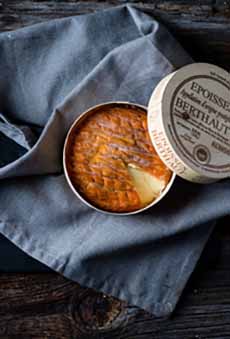|
November 8th is Cook Something Bold & Pungent Day.
What is pungent food?
Pungent is one of the five tastes: bitter, salty, sweet, sour and pungent.
There are different interpretations of pungent, especially in ayurveda and diets that evolved from Eastern medicines.
For the purpose of the American diet, we propose that pungent food:
Has a strong, sharp smell or flavor, such as in horseradish and washed-rind “stinky” cheeses like Époisses (photo #3) and the oft-maligned Limburger and the southeast Asian fruit, Durian*.
Pungency also refers to the spiciness or hotness in foods such as chili peppers, black pepper, ginger and horseradish/wasabi†.
Depending on your palate and the particular food at hand, pungent can be a positive or negative word. “Whew, that’s pungent!” probably falls into the latter category.
> The year’s 12 hot and spicy holidays.
> The different types of chile peppers: a photo glossary.
PUNGENT VS. PIQUANT
Before hot chiles became prevalent in the American diet, “spicy” referred to strong spice flavors such as cinnamon, curry and garlic.
If the level of flavor is more moderate than “pungent,” use the term “piquant.”
Moderately sharp flavors fall into the piquant category: radishes, sauerkraut and strong raw onions, for example.
Examples of piquant spices include cardamom, cayenne, cloves, curry, ginger, mustard and paprika.
To sum it up:
Pungent/pungency always “refers to a very strong taste.
Piquant/piquancy refers to any spices and foods that are ‘agreeably stimulating to the palate,” in other words to food that is spicy in the general sense of ‘well-spiced’ [source].
MORE FOOD WORDS
Four more words:
Ambrosial: extremely pleasing to the senses, especially of taste or smell. Examples: pears, strawberries.
Gustatory: related to or associated with eating or the sense of taste.
Postprandial: occurring after a meal. Example: a postprandial walk around the block, a postprandial nap.
Umami: a taste sensation that is meaty or savory and is produced by several amino acids and nucleotides. Example: parmesan cheese, soy sauce.
Also:
Connoisseur: see gastronome.
Epicure: a connoisseur who cultivates a refined taste, especially in food and wine.
Foodie: A person who has a passion for high quality food, and pursues it with zeal.
Gastronome: a gourmet who puts emphasis on connoisseurship (in-depth knowledge of the cuisine)as well as sensuous enjoyment.
Glutton: a person who eats voraciously, excessively and indiscriminately.
Gourmand: a person who is fond of good eating, often to excess, but generally a lover of good food as opposed to any food.
Gourmet: a fine food enthusiast who pursues the complex and sophisticated flavors of cuisines.
Bon appétit!
|
|

[1] Hot chiles are pungent (here, jalapeño and habanero chiles (photo © Rick’s Picks Pickles).

[2] Sauerkraut: piquant (photo by Elvira Kalviste | © The Nibble).

[3] Epoisses cheese: stinky and absolutely delicious (photo © DiBruno Bros.).
|
________________
*While most of us have never been near a durian, in Asia its potent stench has gotten it banned from public transportation, hotels and planes [source]. That’s a pungent aroma! However, the fruit inside has a sweet, custardy taste, often compared to creamy cheesecake.
†The western horseradish root, Armoracia rusticana, is a cousin of the Japanese root, Eutrema japonicum. Both are members of the Brassicaceae family, also called the Cruciferous family. Other cruciferous vegetables include arugula, bok choy, broccoli, Brussels sprouts, cabbage, cauliflower, collard greens, horseradish, kale, kohlrabi, mizuna, mustard greens, radish, rapeseed/canola, rapini (broccoli rabe), rutabaga, tatsoi, turnips and watercress.
CHECK OUT WHAT’S HAPPENING ON OUR HOME PAGE, THENIBBLE.COM.
|





